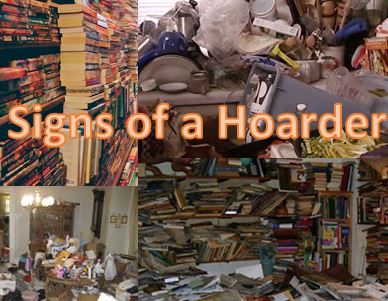The signs of being a hoarder aren’t always as obvious as the pictures above. Older loved ones often accumulate many belongings over a lifetime. What makes someone a hoarder: when does the normal accumulation of belongings cross into potentially detrimental hoarding behavior? How can you identify if your parent is a hoarder or if you’re being overly concerned?
What Distinguishes a Hoarder
Hoarding is the persistent difficulty discarding or parting with possessions, regardless of their actual value (Anxiety and Depression Association of America).
Someone who hoards shows the following symptoms, which help to distinguish a hoarder from someone who simply has too many belongings:
- Inability to throw away items
- Severe anxiety about discarding items or shown when attempting to discard them
- Great difficulty organizing items
- Indecision (about what to keep or where to put possessions–may say things like, “I’m trying to decide which room would be best for these papers” when the papers have been in the hallway for many years)
- Distress (the possessions are often not a pleasure for the person but cause embarrassment or anxiety)
- Protectiveness of the items: suspicion of other people touching them
- Obsessive thoughts and actions: irrational fears of running out of/needing items, checking obsessively on the items whereabouts or counting
- Functional impairments: problems experienced due to the hoarding behavior such as compromised living space and home safety, health hazards, financial and relationship problems and isolation
As you can see, there are some key differences between a hoarder and a collector (or someone whose possessions have accumulated due to physical, financial, or other barriers to getting rid of them). A collector will take pride in items and often display them in an organized fashion.
Though a collector may spend a great deal of time collecting and finding information about what he/she collects, this behavior doesn’t cause functional life problems. The behavior of a collector tends to cause pleasure, where for a hoarder the possessions cause distress and anxiety. Despite this, the hoarder most often doesn’t see the behavior as a problem.
Research about Hoarding
Hoarding was first defined as a mental disorder in the 5th edition of the DSM (Diagnostic and Statistical Manual of Mental Disorders) in 2013. It has been associated with Obessive Compulsive Disorder, though its features are a bit distinctive (such as the lack of awareness/acknowledging the problem, whereas OCD patients typically identify a problem but cannot stop the behavior). Hoarding doesn’t seem to stem from the same neurological mechanisms as OCD or respond to the same medications. Research professionals believe there may be a few different types of disorders at play in hoarders (some combined with OCD or as a part of OCD behavior, while “pure hoarding” is an independent disorder). Hoarding is more common in people with other issues such as depression, anxiety and ADHD. A hoarder has often experienced a major life stressor, such as death of a loved one or divorce, and difficulty coping.
Signs of hoarding behavior may show up in childhood, but its symptoms are usually worst in later life as the hoarder has had time to accumulate possessions. Many times we see cases where the hoarding was somewhat hidden (or known only to close family, who had little success dealing with it) until the person becomes ill, experiences falls/gets hurt or needs eldercare services to come into the home.
Help for the Hoarder
Dealing with a hoarder can be very frustrating and overwhelming. We will share more in our next post about resources and how our team has helped hoarders and their families. In the meantime, don’t hesitate to contact us online or by phone (727-447-5845) to find out more about help for the hoarder.

 Popular Downloads
Popular Downloads


 Get Our Newsletter!
Get Our Newsletter! Mission Statement
Mission Statement

